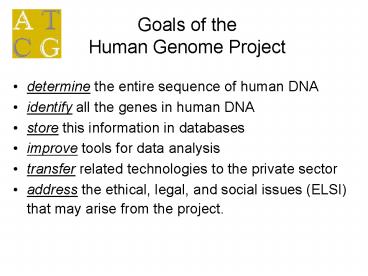Goals of the Human Genome Project - PowerPoint PPT Presentation
1 / 14
Title:
Goals of the Human Genome Project
Description:
An NIH program to map genetic variation. within the human genome. Begun in 2002. Construct a map of the patterns of variation that occur across human populations. ... – PowerPoint PPT presentation
Number of Views:39
Avg rating:3.0/5.0
Title: Goals of the Human Genome Project
1
Goals of the Human Genome Project
- determine the entire sequence of human DNA
- identify all the genes in human DNA
- store this information in databases
- improve tools for data analysis
- transfer related technologies to the private
sector - address the ethical, legal, and social issues
(ELSI) that may arise from the project.
2
Sequencing a genome
Obtain Genomic DNA Sample
Sequence genomic DNA
Assemble sequences in order
Annotate sequence
3
Sanger Sequencing
Chemical reaction that includes DNA
polymerase DNA primer Nucleotide bases (A, T,
G, C) Nucleotide bases that are
labeled Addition of labeled bases stops
reaction. Repeated many times.
4
DNA separated by size using a gel and an electric
current
Sequenced sample put in well
_
DNA moves towards positive charge Short DNA
moves faster
5
How do we sequence a genome?
For the HGP, two approaches were used 1.
Hierarchical sequencing 2. Shotgun sequencing
6
How do we put the sequences together in the
right order?
Genome assembly - based on finding regions of
overlap between individual sequencing fragments
CCCATTAGATGCGATGGGTTAAAA
GGTTAAAAATCGATCCCATTTTACG
Very, very difficult problem for complex genomes!!
7
(No Transcript)
8
Genome Annotation
- Annotation identifying what part of DNA
corresponds to genes, etc. - Compare to known genes
- Gene already described and sequenced
- Expressed Sequence Tags (EST), essentially
randomly sequenced mRNA - Predict genes
- Computer predictions
9
Genome made of two types of DNA
- Euchromatic
- Comprises 93 of your DNA
- Contains most of the genes in your genome
- 99 has been sequenced
- Heterochromatic DNA
- Comprises 7 of your DNA
- Highly repetitive
- Some parts are structural contains centromeres,
telomeres - Gene sparse
- Very difficult to sequence, largely unexplored.
10
Euchromatic DNA
- 2.8 Billion base pairs
- 30,000 genes
- Many fewer than expected, initial guesses were
100,000 genes - 50 have unknown function
- Less than 2 of the total genome
- 98 junk DNA
- Does not code for genes
- Function is unknown - but potentially very
important!!! - Many (50) repeated sequences (e.g.
AGAGAGAGAGAG) and transposable elements
11
What does the draft human genome sequence tell us?
How the genome is arranged Genes occur in
gene-dense jungles and gene poor deserts.
Genes appear to be concentrated in random areas
along the genome, with vast expanses of noncoding
DNA between. Chromosome 1 has the most genes
(2968), and the Y chromosome has the fewest
(231).
12
HapMap
An NIH program to map genetic variation within
the human genome
- Begun in 2002
- Construct a map of the patterns of variation
that occur across human populations. - Facilitate the discovery of genes involved in
complex human traits and diseases.
13
Evolutionary Genomics - comparing genomes of
different species to learn about genome evolution
and function
Gene number does not directly scale with
complexity of organism!
14
What do evolutionary comparisons tell us?
- How the Human Compares with Other Organisms?
- Humans have 3X as many kinds of proteins as
the fly or worm - mRNA transcript "alternative splicing" and
chemical modifications to the proteins. - This process can yield different protein products
from the same gene. - Large portions of non-genic DNA highly conserved,
suggesting the serve some function.































